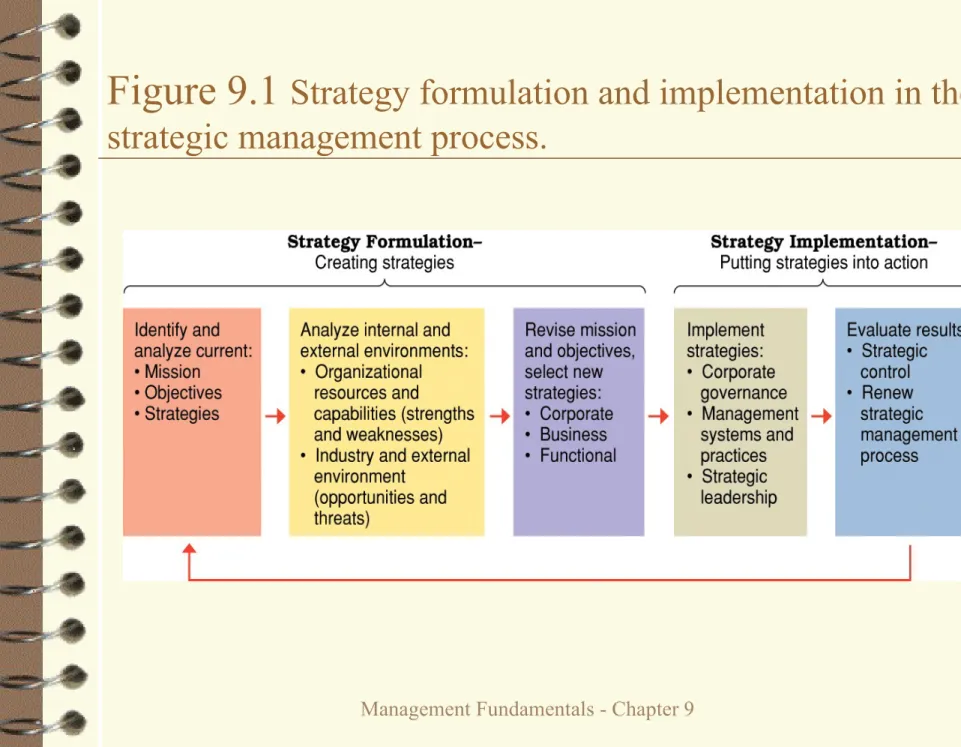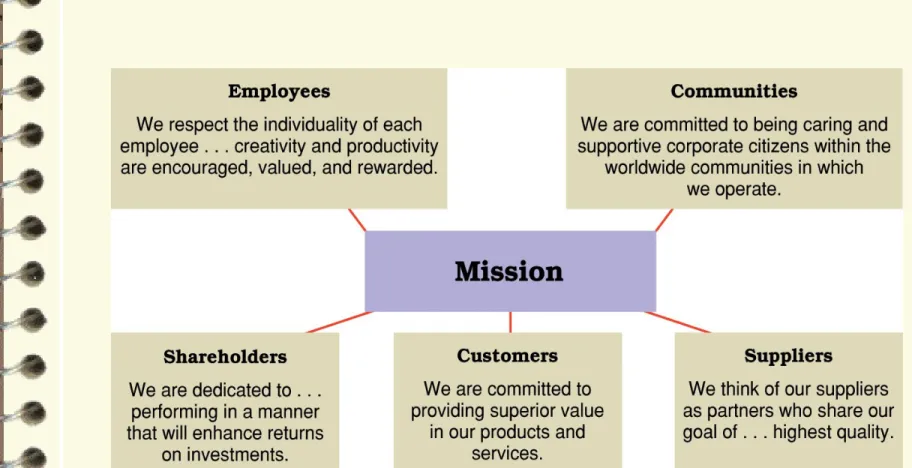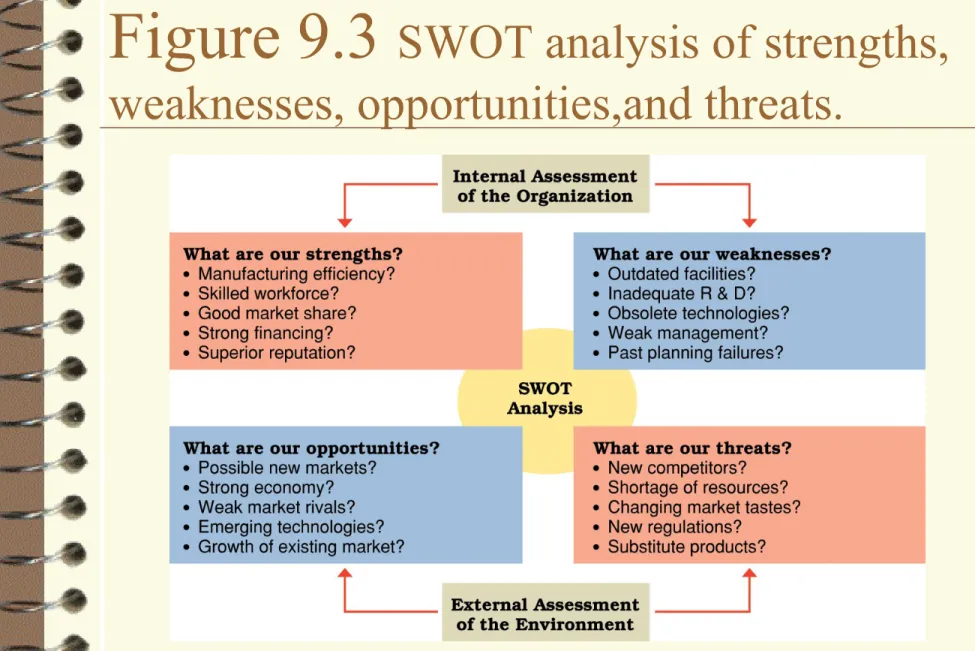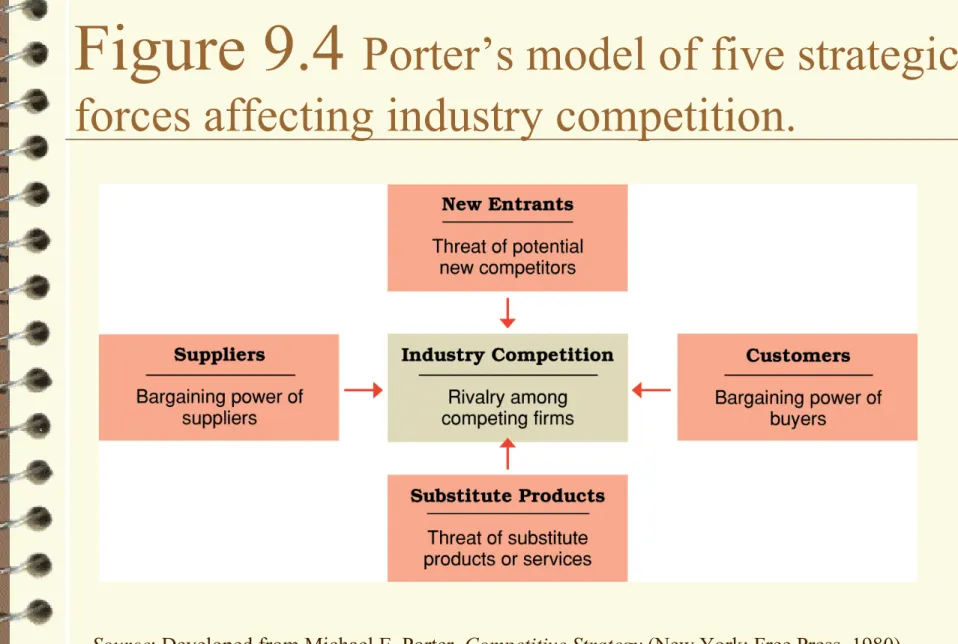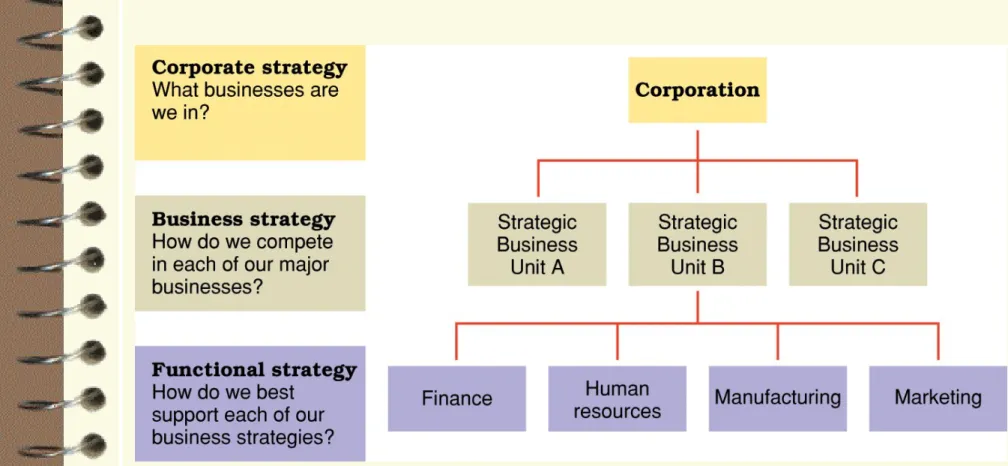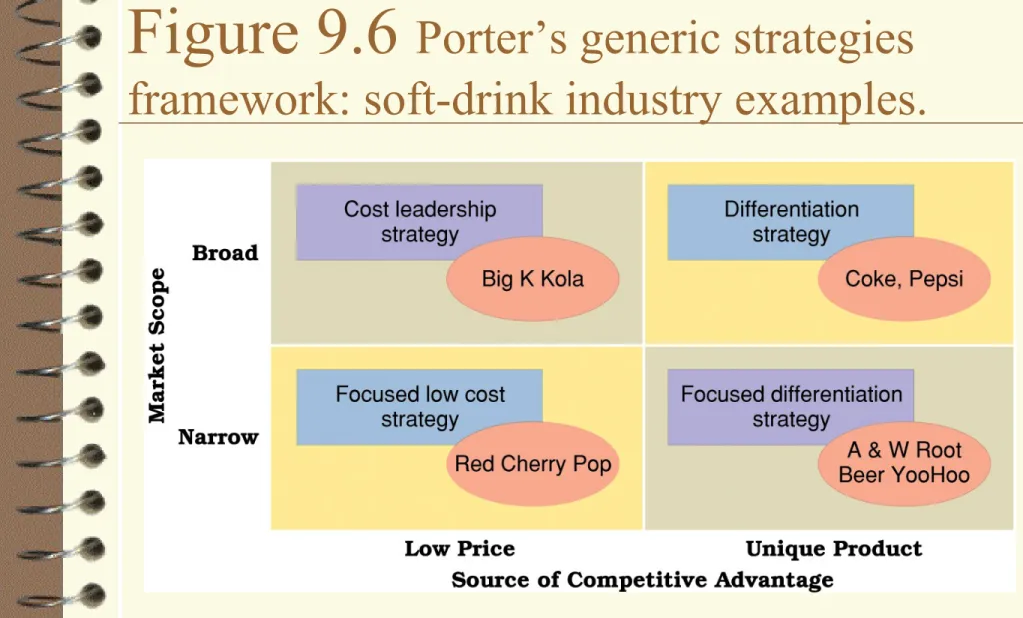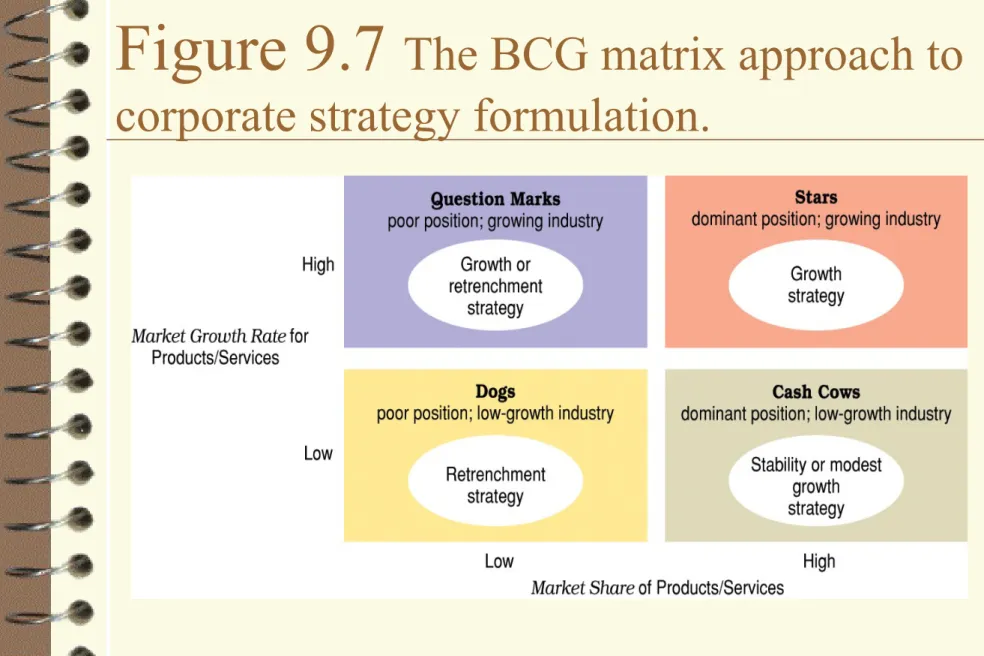PowerPoint Presentation to Accompany Chapter 9 of
Management Fundamentals
Canadian Edition
Schermerhorn Wright
Prepared by: Michael K. McCuddy Adapted by: Lynda Anstett & Lorie Guest Published by: John Wiley & Sons Canada, Ltd.
Planning Ahead — Chapter 9 Study Questions
What are the foundations of strategic competitiveness?
What is the strategic management process?
What types of strategies are used by organizations?
How are strategies formulated?
What are current issues in strategy
implementation?
Study Question 1: What are the foundations of strategic competitiveness?
Basic concepts of strategy:
– Competitive advantage — operating with an attribute or set of attributes that allows an organization to outperform its rivals.
– Sustainable competitive advantage — one that is difficult for competitors to imitate.
Study Question 1: What are the foundations of strategic competitiveness?
Basic concepts of strategy (cont.):
– Strategy — a comprehensive action plan that identifies long-term direction for an
organization and guides resource utilization to accomplish organizational goals with
sustainable competitive advantage.
– Strategic intent — focusing all organizational energies on a unifying and compelling goal.
Study Question 1: What are the foundations of strategic competitiveness?
Basic concepts of strategy (cont.):
– Strategic management — the process of
formulating and implementing strategies to accomplish long-term goals and sustain
competitive advantage.
Study Question 1: What are the foundations of strategic competitiveness?
Goal of strategic management is to create above-average returns for investors.
– Returns exceeding those for alternative opportunities at equivalent risk.
– Earning above-average returns depends in part on the organization’s competitive environment.
Study Question 1: What are the foundations of strategic competitiveness?
Environments and competitive advantage:
– Monopoly.
• Only one player and no competition.
• Creates absolute competitive advantage.
– Oligopoly.
• Few players not directly competing against each other.
• Long-term competitive advantage in defined market segment.
– Hypercompetition.
• Several players directly competing against each other.
• Any competitive advantage is only temporary.
Study Question 2: What is the strategic management process?
Strategy formulation
– The process of creating strategy.
– Involves assessing existing strategies,
organization, and environment to develop new strategies and strategic plans capable of
delivering future competitive advantage.
Figure 9.1 Strategy formulation and implementation in the strategic management process.
Study Question 2: What is the strategic management process?
Strategic question for strategy formulation:
– What is our business mission?
– Who are our customers?
– What do our customers consider value?
– What have been our results?
– What is our plan?
Study Question 2: What is the strategic management process?
Strategy implementation
– The process of allocating resources and putting strategies into action.
– All organizational and management systems must be mobilized to support and reinforce the accomplishment of strategies.
Study Question 2: What is the strategic management process?
Essential tasks for strategy implementation:
– Identify organizational mission and objectives.
– Assess current performance vis-à-vis mission and objectives.
– Create strategic plans to accomplish purpose and objectives.
– Implement the strategic plans
– Evaluate results; change strategic plans and/or implementation processes as necessary.
Study Question 2: What is the strategic management process?
Analysis of mission:
– The reason for an organization’s existence.
– Good mission statements identify:
• Customers
• Products and/or services
• Location
• Underlying philosophy
– An important test of the mission is how well it serves the organization’s stakeholders.
Figure 9.2 How external stakeholders can be valued as strategic constituencies of organizations.
Study Question 2: What is the strategic management process?
Analysis of values:
– Values are broad beliefs about what is or is not appropriate.
– Strong core values for an organization helps build institutional identity, gives character to an organization, and it backs up the mission statement.
– Organizational culture reflects the dominant value system of the organization as a whole.
Study Question 2: What is the strategic management process?
Organizational culture
– Shapes the values of managers and other organization members.
– Points people in common directions.
– Helps build institutional identity.
– Gives character to the organization in the eyes of employees and external stakeholders.
– Backs up the mission statement.
– Guides the behavior of organizational members in meaningful and consistent ways.
Study Question 2: What is the strategic management process?
Analysis of objectives:
– Operating objectives direct activities toward key and specific performance results.
– Typical operating objectives:
• Profitability
• Market share
• Human talent
• Financial health
• Cost efficiency
• Product quality
• Innovation
Study Question 2: What is the strategic management process?
What are our Strengths?
– Manufacturing efficiency?
– Skilled workforce?
– Good market share?
– Strong financing?
– Superior reputation?
What are our Weaknesses?
– Outdated facilities?
– Inadequate research and development?
– Obsolete technologies?
– Weak management?
– Past planning failures?
Study Question 2: What is the strategic management process?
Analysis of organizational resources and capabilities:
– Important goal of assessing core competencies.
– Potential core competencies:
• Special knowledge or expertise.
• Superior technology.
• Efficient manufacturing approaches.
• Unique product distribution systems.
Figure 9.3 SWOT analysis of strengths,
weaknesses, opportunities,and threats.
Study Question 2: What is the strategic management process?
What are our Opportunities?
– Possible new markets?
– Strong economy?
– Weak market rivals?
– Emerging technologies?
– Growth of existing market?
What are our Threats?
– New competitors?
– Shortage of resources?
– Changing market tastes?
– New regulations?
– Substitute products?
Study Question 2: What is the strategic management process?
Analysis of industry and environment:
– Assessment of macro environment:
• Technology.
• Government.
• Social structures and population demographics.
• Global economy.
• Natural environment.
– Analysis of industry environment:
• Resource suppliers.
• Competitors.
• Customers.
Figure 9.4 Porter’s model of five strategic
forces affecting industry competition.
Study Question 3: What types of strategies are used by organizations?
Strategic forces to be examined in conducting an industry analysis:
– Industry competitors – New entrants
– Suppliers – Buyers
– Substitutes
Figure 9.5 Three levels of strategy in organizations—
corporate, business, and functional strategies.
Study Question 3: What types of strategies are used by organizations?
Strategic implications of strategic forces:
– Unattractive industry.
• Five forces are favorable for the firm.
– Attractive industry.
• Five forces are unfavorable for the firm.
Study Question 3: What types of strategies are used by organizations?
Questions addressed by different strategic level:
– Corporate strategy
• In what industries and markets should we compete?
– Business strategy
• How are we going to compete for customers in this industry and market?
– Functional strategy
• How can we best utilize resources to implement our business strategy?
Study Question 3: What types of strategies are used by organizations?
Growth and diversification strategies:
– Growth strategies
• Seek an increase in size and the expansion of current operations.
– Types of growth strategies:
• Concentration strategies
• Diversification strategies
– Related diversification – Unrelated diversification – Vertical integration
Study Question 3: What types of strategies are used by organizations?
Restructuring and divestiture strategies:
– Readjusting operations when an organization is in trouble.
– Retrenchment
• Correcting weaknesses by making changes to current operations.
• Liquidation
• Restructuring
– Downsizing and rightsizing
• Restructuring through divestiture
Study Question 3: What types of strategies are used by organizations?
Global strategies:
– Globalization strategy.
• World is one large market; standardize products and advertising as much as possible.
• Ethnocentric view.
– Multidomestic strategy.
• Customize products and advertising to local markets as much as possible.
• Polycentric view.
– Transnational strategy
• Balance efficiencies in global operations and responsiveness to local markets.
• Geocentric view.
Study Question 3: What types of strategies are used by organizations?
Cooperative strategies
– Strategic alliances — two or more
organizations partner to pursue an area of mutual interest.
– Types of strategic alliances:
• Outsourcing alliances
• Supplier alliances
• Distribution alliances
Study Question 3: What types of strategies are used by organizations?
E-business strategies
– The strategic use of the Internet to gain competitive advantage.
– Popular e-business strategies
• Business-to-business (B2B) strategies
• Business-to-customer (B2C) strategies
Study Question 3: What types of strategies are used by organizations?
Web-based business models:
– Brokerage model – Advertising model – Merchant model
– Subscription model – Infomediary model – Community model
Study Question 4: How are strategies formulated?
Opportunities for achieving sustainable competitive advantage:
– Cost and quality
– Knowledge and speed – Barriers to entry
– Financial resources
Study Question 4: How are strategies formulated?
Porter’s generic strategies model
– Business-level strategic decisions are driven by:
• Market scope
• Source of competitive advantage
– Market scope and source of competitive
advantage combine to generate four generic strategies.
Figure 9.6 Porter’s generic strategies
framework: soft-drink industry examples.
Study Question 4: How are strategies formulated?
Porter’s generic strategies for gaining competitive advantage:
– Differentiation strategy – Cost leadership strategy
– Focused differentiation strategy – Focused cost leadership strategy
Study Question 4: How are strategies formulated?
Portfolio planning approach
– Designed to help managers decide on investing scarce organizational resources among
competing business opportunities.
– Useful for multibusiness or multiproduct situations.
Study Question 4: How are strategies formulated?
BCG matrix
– Ties strategy formulation to analysis of business opportunities according to …
• Industry or market growth rate
– Low versus high
• Market share
– Low versus high
Figure 9.7 The BCG matrix approach to
corporate strategy formulation.
Study Question 4: How are strategies formulated?
BCG matrix — business conditions and related strategies:
– Stars
• High share/high growth businesses.
• Preferred strategy — growth.
– Cash cows
• High share/low growth businesses.
• Preferred strategy — stability or modest growth.
Study Question 4: How are strategies formulated?
BCG matrix—business conditions and related strategies (cont.):
– Question marks
• Low share/high growth businesses.
• Preferred strategy — growth for promising question marks and restructuring or divestiture for others.
– Dogs
• Low share/low growth businesses.
• Preferred strategy — retrenchment by divestiture.
Study Question 4: How are strategies formulated?
Types of adaptive strategies:
– Prospector strategy
• Pursuing innovation and new opportunities in the face of risk and with prospects for growth.
– Defender strategy
• Protecting current market share by emphasizing existing products and current share without seeking growth.
– Analyzer strategy
• Maintaining stability of a core business while exploring selective opportunities for innovation and change.
– Reactor strategy
Study Question 4: How are strategies formulated?
Incrementalism
– Modest and incremental changes in strategy occur as managers learn from experience and make adjustments.
Emergent strategies
– Develop progressively over time in the streams of decisions that managers make as they learn from and respond to work situations.
Study Question 5: What are current issues in strategy implementation?
Strategic planning failures that hinder strategy implementation:
– Failures of substance
• Inadequate attention to major strategic planning elements
– Failures of process
• Poor handling of strategy implementation
– Lack of participation error –
Study Question 5: What are current issues in strategy implementation?
Corporate governance:
– System of control and performance monitoring of top management.
– Done by boards of directors and other major stakeholder representatives.
– Controversies regarding roles of inside directors and outside directors.
– Increasing emphasis on corporate governance in contemporary businesses.
Study Question 5: What are current issues in strategy implementation?
Strategic leadership
– The capability to inspire people to successfully engage in a process of continuous change,
performance enhancement, and implementation of organizational strategies.
Study Question 5: What are current issues in strategy implementation?
Critical tasks of strategic leadership …
–
Be a guardian of trade-offs.
–
Create a sense of urgency.
–
Ensure that everyone understands the strategy.
–
Be a teacher.
–
Be a great communicator.
COPYRIGHT
Copyright © 2007 John Wiley & Sons Canada, Ltd. All rights reserved. Reproduction or translation of this work beyond that
permitted by Access Copyright (The Canadian Copyright Licensing Agency) is unlawful. Requests for further information should be addressed to the Permissions Department, John Wiley & Sons
Canada, Ltd. The purchaser may make back-up copies for his or her own use only and not for distribution or resale. The author and the publisher assume no responsibility for errors, omissions, or damages caused by the use of these programs or from the use of the
information contained herein.
